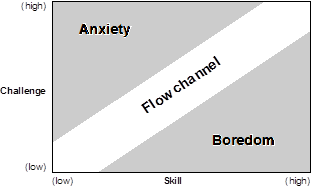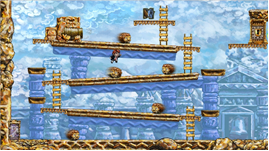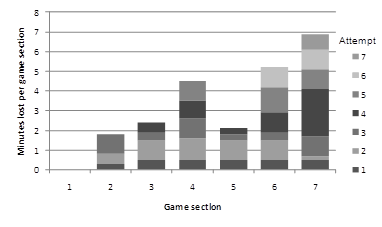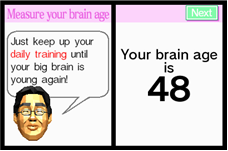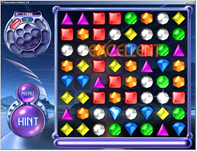In Search of Lost Time:On Game Goals and Failure Costs
ABSTRACT Some time ago, when most video games gave players a limited number of lives, or retries, the difficulty of a game could be measured by how often the player failed in a game. During the last few decades, video games have begun to give players infinite retries, and I will argue that the amount of time the player loses when failing is now the better measure of how difficulty impacts the player. In addition, the meaning of a player's time investment in a game depends on the goal type of the game: to fail in a game, whether failing at the whole game or at a minor task, means that some of the time invested towards the goal has been lost. This is the cost of failure in games, measured in time. But not all goals are the same, and so time can be invested and lost in different ways. When running out of energy in BioShock and being respawned at a new location, some time has been lost, but the goal of completing the game is still achievable. On the other hand, if losing a multiplayer game of Modern Warfare 2, the goal of winning that particular match is forever lost. The former type of goal is permanent; the latter type of goal is transient and tied to that particular instance of the game. Finally, the paper argues that the cost of failure has a psychological component determined by how failure is communicated and by the extent to which replaying game sections is repetitive. Combining this psychological component with the time lost by failing results in a general measure of failure cost. 1. IntroductionTo complete a video game requires the player to successfully complete a range of smaller subtasks. For example, to complete BioShock [1] the player must successfully traverse the game from beginning to end, which in turn requires completing a number of smaller quests, which in turn requires successfully navigating the different areas of the game world. In other words, games tend to be recursive; games tend to consist of tasks that themselves consist of other, smaller tasks. A player can fail or succeed at any task on any level. Whether failing to beat an opponent or failing to solve a puzzle, failing at a task generally results in a punishment from the game's part, translating into a loss of some of the time invested in the game.[1] As will be discussed later, the type of loss depends on the type of goal of the game played. By failure I mean when a player accepts a task, either communicated by the game or invented by the player, and the player does not successfully complete that task. Examples of failure events include the failure of a player to complete a level within 60 seconds, failure to survive an onslaught of opponents, or failure to hit a certain number of notes correctly in Guitar Hero.[12] This paper is not about failure in general, but about the specific question of failure cost in relation to game goals. Punishment is the how the game responds to the player's failure. Punishment is generally dealt as a type of setback such as draining the player's energy resources, subtracting a life, forcing the player to start over and so on. Since it takes time to progress in a game, most punishment in games therefore translates into a type of loss of invested time - not time in the game world, but time spent playing the game. In the early history of video games, the dominant game structure was the arcade model with its limited number of failures per game.[2] Especially when comparing different games with the standard three lives, it is convenient to gauge difficulty simply by looking at how often the player loses a life. During the 1990's and 2000's, however, the limited number of failures/lives in single player games was gradually replaced by unlimited lives.[3] With some melancholy, one writer recently described this development as "The Slow Death of the Game Over".[24] Counter to this, I would argue that the death of Game Over is an unequivocally positive development that has set video games free to experiment with new ways of designing failure. The question of lost time is an alternative perspective on the paradoxical fact of failure in video games. Every day, hundreds of millions of people around the world are failing in video games. These people generally do not like to fail or to be punished by the game for doing so, yet they have chosen to engage in an activity in which they are almost certain to fail - and be punished. In fact, it seems that players prefer the games in which they fail, even though they dislike failing. A recent study revealed that players generally rated a game higher if they had failed at least once while playing it, and indicated that the experience of failing makes players reconsider their strategies, hence adding to the perceived depth of the game.[15] Failure is not as negative as it may sound. 2. Failure countWith few exceptions [28], discussions of difficulty in video games focus mostly on making sure that the difficulty level of the game matches the skill level of the player at any given moment. (For example, [11].) One reason may be that this is a perfect match for the psychological theory of flow as described by Mihaly Csikszentmihalyi [8] (Figure 1). According to flow theory, matching player skill and game difficulty will put the player in the attractive flow state, wherein the player will be completely absorbed by the game. While this is a fruitful perspective, it provides only a partial view of how games interact with players.
Figure 1: The flow state [8] With the recent expansion of the video game audience through casual games and new platforms [16], the role of difficulty in video games has been reconsidered, with it occasionally being suggested that the number of failure events should be reduced to accommodate a broader audience. Jason Kapalka of casual game developer PopCap has argued that “No casual game has ever failed for being too easy”. [17] However, a recent study of downloadable casual game players indicated that the idea of a failure-averse casual player may be something of a myth. One study respondent explained how difficulty and failure were integral to her enjoyment of games:
Furthermore, the survey showed that players were more likely to describe it as a problem for a game to be "too easy" than "too hard". This is not at all surprising if we think outside video games, where most of the games that reach broad audiences do have large amounts of failure events. Consider solitaire card games: most solitaire sessions end in "failure" with the game unsolved. In other words, failure, and punishment for failure, is not the exclusive province of an elite group of video game players, but is completely understood and accepted by the broad population. A recent large-scale European study of people who were not actively playing video games showed that difficulty was not reported as a central concern. The study participants rather described “lack of time” as their primary barrier to playing video games.[21] The temporal cost of playing, and of failure, is apparently an undertheorized aspect of video games that is nevertheless important to a broad audience of players. 3. The Temporal Cost of Failure
Figure 2: Flywrench [18]
Figure 3: Braid [23] The game Flywrench (Figure 2) is a good illustration of why time cost is a more general perspective on difficulty than is "lives" or the number of failures experienced by the player. In Flywrench, the player tends to "die" every few seconds, but at the same time, every failure is punished with a minimal setback, taking the player back only a second or two. Therefore, even though the game is difficult and has a high failure count, the failure cost measured in time is very low, making the game less subjectively punishing than it would at first appear, and giving players good opportunity to experiment. The game Braid (Figure 3) even lets the player rewind at any given point in the game, hence the cost of failure is minimal.[4] In the bigger picture, the trend is also for massively multiplayer online games such as World of Warcraft [6] to deal the player ever smaller punishments for dying.
Figure 4: A model of time in games [14] In earlier work, the author argued that time in video games could be illustrated as two parallel timelines, the play time of the player and the fictional time which is projected from the play time (Figure 4). This illustrated both how the fictional worlds of video games are imaginary extension of the real play time of the player, and how video games tend to present fictional worlds in which time runs faster than real time. What this model does not represent is the fact that video game playing is rarely linear, but rather consists of the player failing, losing time, and retrying specific sections of a game. In other words, the model in Figure 4 represents an idealized video game session in which the player never fails. Tychsen and Hitchens have observed that game-playing is not as linear as the model suggests, and proposes the concept of progress time[5] to describe the individual player's time use. [32]
Figure 5: Distribution of player deaths on the cs_gravelpit level in Team Fortress 2 [33] Within the last few years, improved data collection methods in video game development have spawned the technique of representing the spatial distribution of player failures using heat maps [33] as shown in Figure 5 where colored areas represent the most frequent locations of player death. In addition, some work has also been done recording and representing player failure and skill development over time. [27]
Figure 6: Simulated representation of cumulative time expenditure per game section It would be possible to create a temporal representation of the time cost of failure per section throughout a game. Figure 6 shows such a simulated representation of a hypothetical game in which the player completes section 1 at first attempt, fails once or more in the following sections, completes section 5 easily and struggles on section 6 and 7. The vertical axis thereby represents the total time lost per game section.[6] This more realistically illustrates the player's time investment than does the idealized Figure 4. 4. Permanent and Transient GoalsTime, however, is not spent in the same way in all games. When failing to solve a Solitaire card game, or when losing a match in Modern Warfare 2 [13] the player has certainly not achieved the desired outcome from his or her time investment, but it would be a strain to say that the player failed to "advance toward a goal" since these two example games have no goal that can be finally completed.[7] In completable games, to fail will delay the completion of the task at hand and incur a time cost, but in Solitaire or Modern Warfare 2, failure is a feature of that specific game session, and no time invested can make up for it. It seems, then, that games can have different types of goals, distinguished by what happens when the player succeeds or fails at them. BioShock is a mostly linear game with a permanent goal: once the player has completed the game, this is a permanent feature of the player - the player will always be someone who has completed BioShock. On the other hand, winning a match in Modern Warfare 2 only means that the player has won that match: this is a transient goal, tied to that specific game session of Modern Warfare 2. This also applies to Solitaire card games, where the goal is not to complete Solitaire once and for all, but to solve the specific set of randomized cards of that game of Solitaire. The transient goal of winning a particular match is prevalent in competitive multiplayer games, but for single player games we find both completable games with permanent goals (BioShock) and replayable games with transient goals (Solitaire). These transient goals and permanent goals have different kinds of shelf life: A transient goal expires at the end of the game, regardless of whether the player fails or succeeds: A permanent goal becomes inactive only once success has been reached. This means that the time investment of the player is quite different in relation to these two types of goals: when dealt a setback in a game with the permanent goal of completing it (such as BioShock), the player will have lost some time, and will be able to invest more time in order to make up for the progress that was lost. But for games with transient goals, it can sound strange to describe the time invested as "lost" when a game of Solitaire is not solved. Why? Because there is no permanent measure of progress against which to determine whether the time invested in the game session was lost, and because such replayable games may encourage a focus away from the specific goal of a game session toward the player's gradually improving skills over time. Losing a game with a transient goal is therefore most easily described as a setback or a loss of time investment if there is a larger permanent goal around it, such as winning over a rival or solving a specific Solitaire variant for the first time. This is straightforward: since games tend to consist of tasks that contain other tasks within them, a permanent goal can always subsume a transient goal. For example, winning a specific tennis match can be connected to the larger permanent goal of winning a tennis Grand Slam. Part of the function of the achievement system on Xbox 360 is similarly to add permanent goals on top of games with transient goals. For example, the "Dynasty" achievement in Team Fortress 2 [34] awards the player with 10 points for winning 20 games, making a permanent goal out of the transient goals of the individual game sessions, and making the time invested in the game more permanently documented. 5. Communicating Failure
Figure 7: Gears of War [10]
Figure 8: Super Real Tennis [29]
Figure 9: Brain Age [22] This has so far been a formal consideration of failure in games, focusing on its temporal cost. Failure also has the psychological factor of how it is communicated. Take a game like Gears of War (Figure 7), where the loss of a life is communicated to the player by turning the screen red with blood while showing the corpse of the player's avatar. Here failure is communicated somewhat neutrally via an in-game element. Compare this to the cell phone game Super Real Tennis (Figure 8), where Game Over is followed by the game telling the player to "check basic operation methods". The game here signals to the player that he or she is uniquely unskilled, still unable to understand basic methods after having played it numerous times. The theory of learned helplessness explains why this may be experienced negatively. According to this theory, certain perceptions of failure can have a profound negative impact on a user's self-image and belief in his/her competence. Learned helplessness can be a problem in an educational setting, where the wrong kind of feedback can make a student give up entirely. Extending this to video games, one useful formulation describes three dimensions to how a user can attribute failure to a cause. [4] For each of these dimensions, the first option is most likely to lead to a situation of learned helplessness where the player feels unable to improve his/her performance in a game: · Internal vs. external: Attributing failure to the user or to the test (game). · Stable vs. unstable: Whether the user believes failure to be consistent or subject to chance or improvement · Global vs. specific: Whether the user attributes failure to general inability or inability in this specific task. This helps explain why Super Real Tennis' way of communicating failure is problematic: by repeatedly referring to the basic operation methods, the game cues the player to attributing failure to an internal cause (the player) and to believing that the cause is stable with no likelihood of improvement (since the game does not acknowledge that the player is making any progress). The player is indirectly compared to other players, suggesting that other players do much better, but that the player can never live up to them. This way of examining the communication of failure also shows how a negative comparison to other players can strangely work as a motivating factor: The common experience in Brain Age (Figure 9) is for players to be told that their brain is older than their actual age, hence comparing them negatively to the average human. The game then promises players that they can rectify this by playing the game. In the terms presented above, both Super Real Tennis and Brain Age attribute the poor result to the player (internal cause), but where Super Real Tennis suggests that the player is not improving (stable cause), Brain Age promises that the player will improve with practice (unstable cause). This small difference is what makes a poor performance in Brain Age more motivating than in Super Real Tennis. It should be noted that the communication of failure is not only a function of game design, since players may comment on each other's performances in both single and multiplayer games.[8] 6. Repetition and Randomization
Figure 10: Bejeweled 2 Deluxe [25] There was a period of time, especially in home computer games with permanent goals, where games would involve a large number of levels, where failing (dying) would force a player to replay a level from the beginning, and where every level was completely identical every time. The monsters were in the same places, timed the same way, etc... Hence mastering a level was simply a question of rote learning, and setbacks were therefore subjectively quite repetitive and very punishing. Compare this to typical design in not just puzzle games, but many other games. Randomization makes replaying part of the game somewhat more interesting and less punishing. In Bejeweled (Figure 10), replaying the same level over and over involves some variation as the tiles that must be matched are shuffled. Randomization is also used in Solitaire, for example, where the player is in a sense always replaying “the same level”, but where that level is new every time due to randomization. This is a psychological aspect of lost time, where the question is not the amount of time lost, but the subjective quality of the time spent replaying a game section. For this purpose, replaying needs not be random in a technical sense; the point is whether the player has to perform the same actions in the same order every time. Randomization is a way to maintain the player's interest, even when the player is forced to replay part of a game. In the big picture, the question of repetition used to be closely tied to the question of whether a game had transient or permanent goals. Certainly, replayable single-player games with transient goals such as Solitaire, Bejeweled or Oasis [19] are heavily randomized, giving players new variations every time they play one of these games. By comparison, going back to the 1980's, many single player games with permanent goals such as the platform game Manic Miner [30] had no randomization and only a limited number of lives, making for game experiences that were extremely punishing both in terms of time lost and in terms of repetition. Recent years have seen randomization become more of a stable design feature even in completable games with permanent goals. In a recent high-profile example, the mostly linear action-adventure game Uncharted 2 [20] randomizes the movement of enemies every time the player retries a section. This prevents the player from replaying a section using a memorized sequence of actions, and it opens for the possibility that the player may experience surprises and new challenges, even when not progressing in the overall game. In combination with frequent save points and infinite lives, the punishment for failure is minimal, and the game's total failure cost is therefore low. This type of design is possibly a requirement for mass market success now. 7. ConclusionI have argued for the use of lost time as a general measure of how difficulty, failure, and punishment affect the player, and I have argued that the loss of time is experienced differently depending on whether a game has a permanent goal that can be reached once and for all, or a transient goal that is specific to a match or game session. It follows that the use of time in a permanent goal-game also has a more instrumental character than in a replayable game with a transient goal. In the latter case, the fundamental objective of the game may be the process of playing, rather than completing the game. Seeing failure in terms of lost time provides a way of understanding how games fit with the lives and psychologies of players. It opens to asking a number of more detailed questions such as: what amount of time is the player willing to invest without a guarantee that he or she will make progress in a given game session? How large chunks of time are the player willing to commit? Does the player need to know the potential time commitment ahead of time, or is the player willing to postpone other activities in order to complete a game section? In addition to the quantifiable cost that is lost time, failure also has a psychological cost that depends on how failure is communicated and whether game setbacks forces the player to experience a repetitive replaying of a game section. Combining these two perspectives gives a general measure of failure cost: A clear example of a low-cost game would be the casual game Peggle [26], with its minimal amount of lost time as well as randomized levels and a supportive way of communicating failure. An example of a high-cost game could be Mega Man [7], since it features large temporal punishments for failure and repetitive retries of specific levels. Flywrench, discussed earlier, exemplifies a game that combines high difficulty (failure count) with low cost per failure. In this paper I have not discussed how players can reframe the official goals of a game. For example, one player documented his experience of playing Far Cry 2 with self-imposed permanent death, requiring him to not continue playing if his character were to die [3]. This self-imposed constraint in effect increased the failure cost of the game - a reaction to the continued lowering of failure costs in commercial video games. Video games create a lack for the player to remedy. Video games present worlds that are out of order; the player must then create order. Sometimes players fail to do so, and they often pay a cost in time. This paper has argued for looking at failure cost, to the player, measured in time, and understood psychologically. A game may be a beautiful object, with beautiful strategies and perfect balancing. But a game must compete with laundry, work, dinner appointments, and with the attraction of other emotional experiences. Failure cost is a measure of how a game fits into the lives of players. 8. AcknowledgementsThis is a substantial revision of an argument presented at the Game Developers Conference in San Francisco, 2009. Thanks to the anonymous reviewers for insightful comments. 9. References1. 2K Boston. BioShock. 2K Games (Xbox 360), 2007. 2. Aarseth, E. Aporia and Epiphany in Doom and The Speaking Clock. In M.-L. Ryan, ed., Cyberspace Textuality. Computer Technology and Literary Theory. Indiana University Press, Bloomington, IN, 1999, 31–41. 3. Abraham, B. Permanent Death, Episode 1: An Inauspicious Beginning. SLRC - Subterranean Loner Rendered Comatose, 2009. http://drgamelove.blogspot.com/2009/06/permanent-death-episode-1-inasupicious.html. 4. Abramson, L.Y., Seligman, M.E., and Teasdale, J.D. Learned helplessness in humans: critique and reformulation. Journal of Abnormal Psychology 87, 1 (1978), 49–74. 5. Atari Inc. Asteroids. Atari (Arcade), 1979. 6. Blizzard Entertainment. World of Warcraft. Blizzard Entertainment (Windows), 2004. 7. Capcom. Mega Man. Capcom (NES), 1987. 8. Csikszentmihalyi, M. Flow: The Psychology of Optimal Experience. Harper & Row, New York, NY, 1990. 9. Diener, C.I. and Dweck, C.S. An analysis of learned helplessness: Continuous changes in performance, strategy, and achievement cognitions following failure. Journal of personality and social psychology 36, 5 (1978), 451–462. 10. Epic Games. Gears of War. Microsoft Game Studios (Xbox 360), 2006. 11. Fullerton, T., Swain, C., and Hoffman, S. Game Design Workshop: Designing, Prototyping, and Playtesting Games. CMP Books, San Francisco, CA, 2004. 12. Harmonix Music Systems, Inc. Guitar Hero. RedOctane Inc. (PlayStation 2), 2005. 13. Infinity Ward. Call of Duty: Modern Warfare 2. Activision (PlayStation 3), 2009. 14. Juul, J. Half-Real: Video Games between Real Rules and Fictional Worlds. MIT Press, Cambridge, MA, 2005. 15. Juul, J. Fear of Failing? The Many Meanings of Difficulty in Video Games. In B. Perron and M.J.P. Wolf, eds., The Video Game Theory Reader 2. Routledge, New York, NY, 2008, 237–252. 16. Juul, J. A Casual Revolution: Reinventing Video Games and Their Players. MIT Press, Cambridge, MA, 2009. 17. Kapalka, J. 10 Ways to Make a BAD Casual Game. Casual Connect Magazine, 2006. http://www.casualconnect.org/content/gamedesign/kapalka-tenways.html. 18. messhoff. Flywrench. (Windows), 2007. 19. Mind Control Software. Oasis. PlayFirst, Inc. (Windows), 2005. 20. Naughty Dog. Uncharted 2: Among Thieves. Sony Computer Entertainment (PlayStation 3), 2009. 21. Nielsen Games. Video Games in Europe 2008. Interactive Software Federation of Europe, 2008. 22. Nintendo SDD. Brain Age. Nintendo (DS), 2006. 23. Number None, Inc. Braid. Microsoft Game Studios (XBox 360), 2008. 24. Orland, K. The Slow Death of the Game Over. The Escapist, 2007. http://www.escapistmagazine.com/articles/view/issues/issue_100/556-The-Slow-Death-of-the-Game-Over. 25. PopCap Games. Bejeweled 2 Deluxe. (Windows), 2004. 26. PopCap Games. Peggle. (Windows), 2007. 27. Romero, R. Successful Instrumentation: Tracking Attitudes and Behaviors to Improve Games. Game Developers Conference, (2008). 28. Schell, J. The art of game design. Morgan Kaufmann, Burlington, MA, 2008. 29. Sega Wow Inc. Super Real Tennis. SEGA Corporation (Mobile), 2003. 30. Smith, M. Manic Miner. Bug-Byte (Commodore 64), 1983. 31. Squire, K. Changing the game: What happens when video games enter the classroom. Innovate: journal of online education 1, 6 (2005). 32. Tychsen, A. and Hitchens, M. Game Time: Modeling and Analyzing Time in Multiplayer and Massively Multiplayer Games. Games and Culture 4, 2 (2009), 170–201. 33. Valve. Team Fortress 2 Stats. 2007. http://www.steampowered.com/status/tf2/tf2_stats.php. 34. Valve. Team Fortress 2. Valve (Windows), 2007.
[1] The exception can be found in games where losing a life does not restart the game section, cause any loss of capabilities, or in other ways impede the player's progress. In video games, this goes back to early arcade games like Asteroids [5]. [2] With the caveat that many arcade games offered extra lives for scores above certain thresholds. [3] Some of this change was likely a somewhat delayed reaction to the business model of the console and personal computer markets, where the main source of income was now an upfront purchase rather than a payment per game session as in the arcade. In addition, the increased storage capacity of computer systems made it less pertinent to reuse game sections in order to provide sufficient play time for players. [4] In Braid, rewinding is also part of the core gameplay. [5] Aarseth uses the comparable term negotiation time. [2] [6] In a 2008 presentation, Microsoft Game Studios showed a map of failure counts per level in a game. [27] [7] I am speaking here of the multiplayer mode in Modern Warfare 2. [8] One psychological study distinguished between mastery-oriented children who were likely to focus on remedies for failure, and helpless children who were likely to attribute failure to lack of ability. [9] A study of video games in the classroom observed similar differences between students who saw failure as an opportunity for learning, and those who were discouraged by it. [31] |
